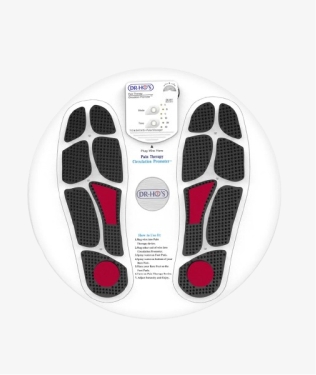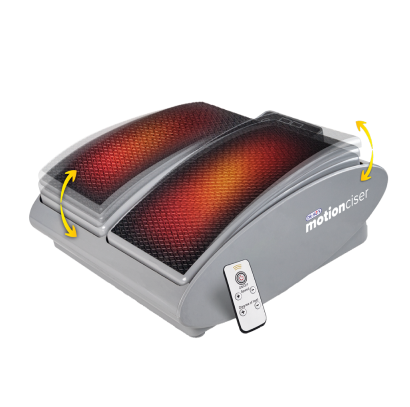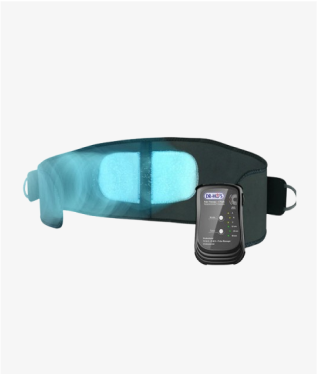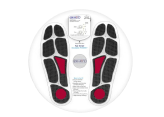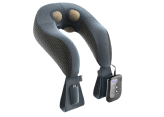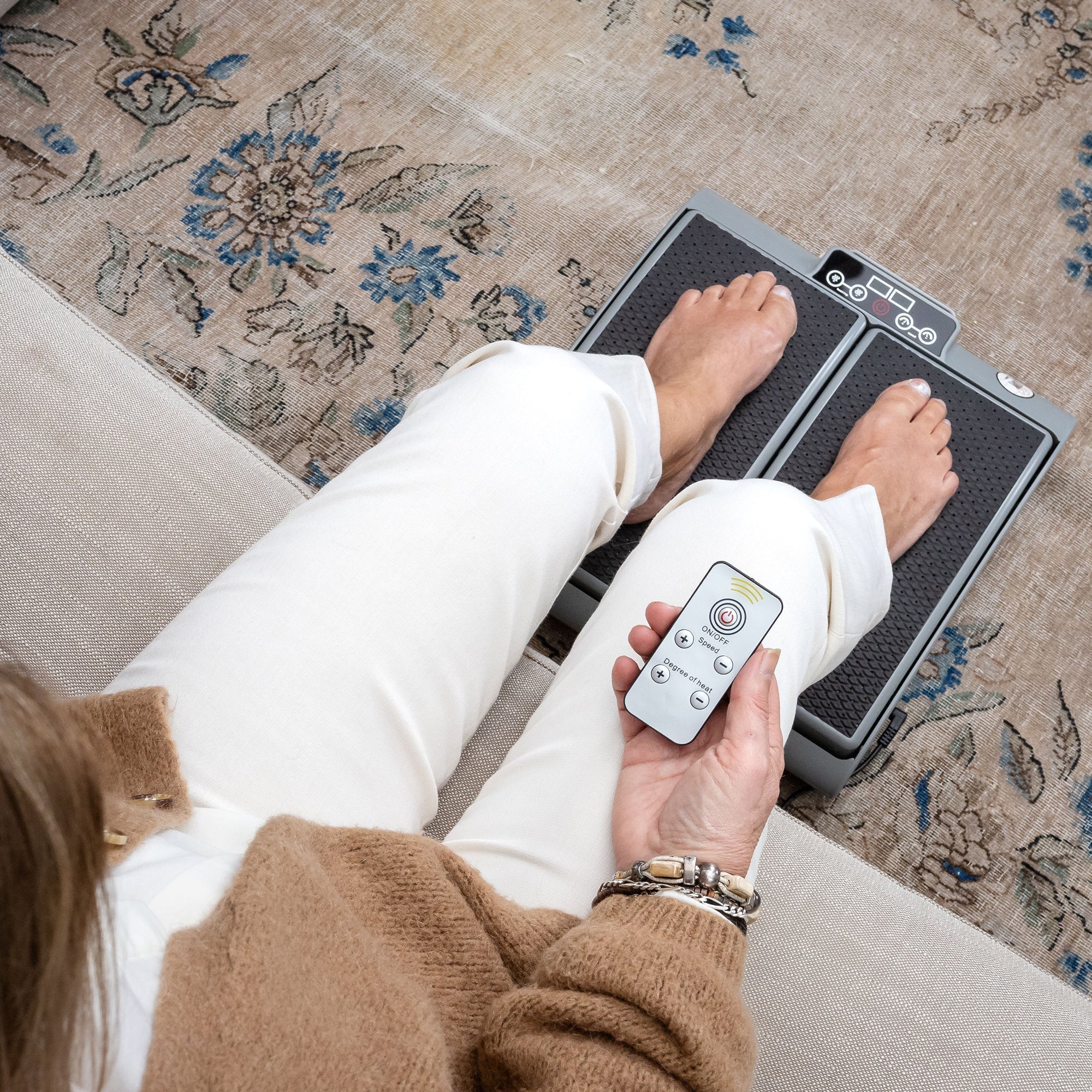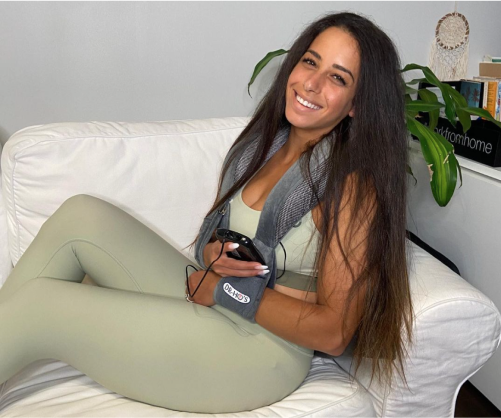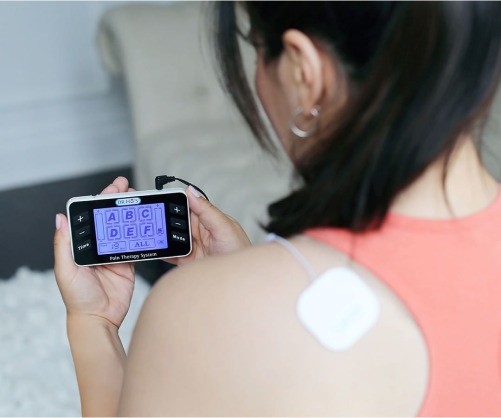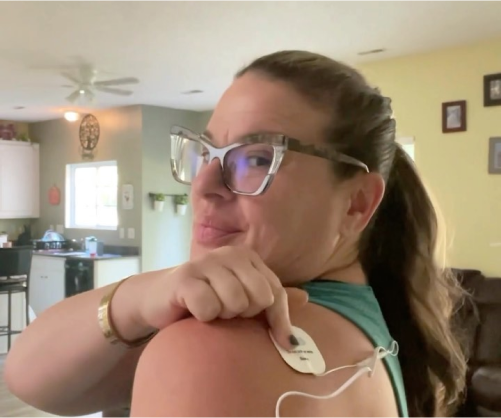Living with fibromyalgia means navigating a complex condition that affects approximately 2-4% of the general population worldwide (StatPearls). The widespread pain, fatigue, and other challenging symptoms can significantly impact quality of life and often require a multifaceted approach to management. While medications play an important role for many, non-drug options like Transcutaneous Electrical Nerve Stimulation (TENS) have gained attention as complementary approaches for pain relief.
DR-HO'S specialized pain relief devices offer innovative technology designed to help manage various types of pain. Our unique 4-in-1 technology combines multiple stimulation methods to address pain and discomfort through a comprehensive approach. In this guide, we'll explore how TENS therapy works, what the research says about its potential benefits for fibromyalgia, and how DR-HO'S devices may help as part of your pain management strategy.
Understanding fibromyalgia
Fibromyalgia is a chronic condition characterized by widespread musculoskeletal pain accompanied by fatigue, sleep disturbances, memory issues, and mood changes. Unlike many other pain conditions, fibromyalgia doesn't have obvious physical causes like inflammation or tissue damage that can be easily measured or observed.
Research suggests that fibromyalgia amplifies painful sensations by affecting how your brain and spinal cord process pain signals. This is sometimes called "central sensitization," where the central nervous system becomes more responsive to pain signals, essentially turning up the "volume" on pain.
Who gets fibromyalgia?
Fibromyalgia can affect anyone, regardless of age or background:
-
In clinical settings, the majority of diagnosed patients are women aged 40 to 60, with a female-to-male ratio of 8–10:1 (Dialogues Clin Neurosci.)
-
However, epidemiological studies using newer diagnostic criteria show a lower female predominance
-
It can occur in all age groups, including children and adolescents
-
Family members of people with fibromyalgia may have a higher risk of developing the condition
Common symptoms
People living with fibromyalgia experience a distinctive pattern of symptoms centered around widespread, chronic pain. This core symptom manifests as discomfort that affects multiple areas on both sides of the body, both above and below the waist. Yet fibromyalgia is far more complex than pain alone.
The constellation of fibromyalgia symptoms typically includes:
-
Generalized pain that moves throughout different body regions
-
Increased pain sensitivity, especially when pressure is applied to specific tender points
-
Overwhelming fatigue that persists despite sleeping
-
Disrupted sleep patterns, including difficulty staying asleep and conditions like restless leg syndrome
-
Mental clarity issues that many patients describe as "fibro fog," affecting concentration and memory
-
Recurring headaches and temporomandibular joint (TMJ) discomfort
-
Morning stiffness that can make starting the day challenging
-
Emotional health challenges including anxiety and depression symptoms
-
Gastrointestinal concerns, with more than half of patients experiencing irritable bowel-like symptoms
-
Sensations of tingling, numbness, or "pins and needles" in the hands, feet, and limbs
DR-HO'S 4-in-1 technology is specifically designed to address many of these symptoms and relieve pain through its comprehensive approach to pain management. By working with your body's natural processes rather than against them, our advanced stimulation technology helps provide temporary relief by encouraging positive nerve and muscle interaction while increasing local circulation—potentially addressing both the pain and some of the associated symptoms that make fibromyalgia so challenging.
Tender points in fibromyalgia
Fibromyalgia is uniquely characterized by specific areas of heightened sensitivity known as tender points. Healthcare providers have identified 18 of these points (9 symmetrical pairs) that form a distinctive pattern across the body. These areas typically respond with discomfort when gentle pressure is applied—a key diagnostic indicator for the condition.

These tender points include:
Upper body
-
Suboccipital muscle insertions: Where the neck muscles connect to the base of the skull
-
Mid-trapezius: The middle portion of the shoulder muscle between neck and shoulder tip
-
Supraspinatus: Above the shoulder blade where back muscles attach
-
Lower cervical: The front neck region just above the collarbone
-
Second rib: Adjacent to the breastbone, approximately two inches below where the collarbone connects
Lower body and extremities
-
Lateral epicondyle: The outer portion of the forearm just below the elbow crease
-
Upper gluteal: The upper outer quadrant of the buttock region
-
Greater trochanter: The prominent bony area on the outer upper thigh
-
Medial knee: The inner knee area just above the joint line
DR-HO'S specialized Pain Therapy Systems are uniquely equipped to address these tender points with precision. Our large, flexible electrode pads are designed to cover multiple tender points simultaneously, allowing for comprehensive coverage with fewer pad placements. This is particularly valuable for fibromyalgia patients, as the condition affects multiple symmetrical body regions.
Challenges of conventional treatments
Managing fibromyalgia often requires a personalized approach that combines medications, exercise, stress management, and other therapies. However, conventional treatments can come with limitations:
-
Medications may have side effects or limited effectiveness
-
Exercise is beneficial but can be difficult when pain is severe
-
Stress reduction is important but not always sufficient alone
-
Many people prefer to minimize medication use when possible
This is why many people with fibromyalgia explore complementary approaches like TENS therapy to help manage their symptoms and reduce pain severity.
What is a TENS unit?
A TENS (Transcutaneous Electrical Nerve Stimulation) unit is a portable, battery-powered device that delivers mild electrical currents through electrodes placed on the skin. These gentle electrical pulses interact with the nervous system to help temporarily reduce pain perception.
Unlike medications that circulate throughout your entire body, TENS therapy works locally at the application area. The electrical currents are completely adjustable, allowing you to find the intensity level that feels most comfortable and effective for your needs.
How DR-HO'S 4-in-1 technology works
DR-HO'S pain relief devices go beyond standard TENS units by combining multiple stimulation methods into DR-HO'S patented AMP 4-in-1 Technology:
-
TENS (Transcutaneous Electrical Nerve Stimulation): Helps block pain signals from reaching the brain using specific electrical frequencies that interact with nerve pathways. This stimulation helps interrupt the transmission of pain signals, potentially providing temporary relief from fibromyalgia discomfort.
-
EMS (Electrical Muscle Stimulation): Gently contracts and relaxes muscles to help reduce tension and improve circulation. This rhythmic action helps address muscle tightness often associated with fibromyalgia while promoting better blood flow to tissues.
-
NMES (Neuromuscular Electrical Stimulation): Targets specific muscle groups to help strengthen and recover. This is particularly beneficial for maintaining muscle function when pain might otherwise limit physical activity.
-
Auto-Modulating Pulse: Auto-modulating pulses automatically vary the waveform and frequency, and this continuous variation helps maximize effectiveness throughout each session.
This multi-dimensional approach works with your body's natural processes to provide a more comprehensive approach to pain management than standard single-function devices. The precise, targeted stimulation helps activate your body's pain-fighting mechanisms while improving local circulation and muscle function.
How TENS may help fibromyalgia symptoms
A TENS device may help fibromyalgia symptoms through several potential mechanisms:
-
Pain signal interference: The electrical pulses can help disrupt pain signals traveling to the brain, potentially providing temporary relief from fibromyalgia pain. This works through the "gate control theory" where non-painful stimuli can help block the transmission of pain signals.
-
Endorphin release: TENS may stimulate the production of endorphins, your body's natural pain relievers. These neurochemicals work similarly to opioids but are produced naturally by your body.
-
Improved circulation: The gentle muscle contractions from DR-HO'S 4-in-1 technology can help increase local blood flow, which may reduce stiffness and discomfort.
-
Muscle relaxation: Reducing muscle tension may help alleviate some of the discomfort associated with fibromyalgia. When muscles are more relaxed, pressure on tender points may decrease.
Remember: while our advanced TENS machine can benefit those with fibromyalgia through its sophisticated combination of TENS, EMS, and NMES guided by our proprietary AMP Technology, proper diagnosis ensures optimal pad placement and treatment protocols. Always consult a healthcare professional for an accurate diagnosis before beginning any treatment program.
Research on TENS for fibromyalgia
While more research and clinical trials are needed, several studies have explored the potential benefits of TENS for fibromyalgia:
A study published in 2020 called the FAST (Fibromyalgia Activity Study with TENS) trial found that TENS therapy reduced movement-related pain and fatigue in women with fibromyalgia. The researchers observed that 44 percent of participants using active TENS reported pain reductions of approximately 30 percent, with similar effects on fatigue. (Arthritis Rheumatol)
Another study found that dual-site (applying stimulation at two different locations) TENS relieved pain intensity from baseline by nearly 50% after one week of use, while single-site TENS reduced pain by about 30%. (Cochrane Database of Systematic Reviews)
It's important to note that individual responses to TENS therapy vary, and what works for one person may not work the same way for another. TENS should be considered as one potential tool in a comprehensive approach to managing fibromyalgia symptoms.
Using a TENS unit for fibromyalgia
For fibromyalgia pain, electrode placement can be customized to your specific pain areas, including the 18 classic tender points. Common placements include:
-
Upper back/neck region: Particularly helpful for tension and upper body pain
-
Lower back: To address lower back discomfort
-
Shoulder areas: Targeting common tender points
-
Hip region: Another common area of fibromyalgia pain
DR-HO'S large, flexible pads are designed to cover more area, allowing you to target multiple tender points simultaneously. This broader coverage is especially beneficial for the widespread nature of fibromyalgia pain.
Mapping TENS pad placement to fibromyalgia tender points
DR-HO'S Pain Therapy System 4-Pad Essential Package provides the ideal solution for addressing fibromyalgia's distinctive tender point pattern. This comprehensive package includes
-
4 Regular Body Pads
-
2 Large Body Pads
This gives you the flexibility to target multiple tender points simultaneously. The versatile pad assortment allows for dual-site therapy—a particularly effective approach for fibromyalgia's symmetrical pain patterns.

Upper body tender points
-
Neck and base of skull area: Place two smaller electrode pads at the base of the neck, targeting the suboccipital muscle insertions where neck muscles connect to the skull. For maximum effectiveness, lie on your back with your neck supported by a pillow or rolled towel.
-
Shoulder and upper back: Use two large pads to target the mid-trapezius and supraspinatus tender points. Place one pad in the front of the shoulder and one at the back, creating a "sandwich" effect that helps direct relief to this commonly affected area.
-
Upper chest area: For the tender points near the second rib (adjacent to the breastbone), place two medium pads horizontally below the collarbone, about 2 inches down from where it connects to the sternum.
-
Forearm region: To address the lateral epicondyle tender points, use two pads on the outer portion of each forearm—one pad closer to the elbow, and one pad closer to the wrist. Avoid placing directly over the elbow joint itself.

Lower body tender points
-
Hip and buttock area: For upper gluteal and greater trochanter tender points, use two large pads—one placed on the front of the hip and one on the back, creating a "surround" effect for the joint.
-
Inner knee region: For medial knee tender points, place large pads on either side of your knee, creating a "sandwich" effect while ensuring the pads don't contact the kneecap directly.
Our proprietary 4-in-1 technology works with your body's natural processes, combining TENS for nerve pathway modulation, EMS for gentle muscle stimulation, NMES for targeted muscle engagement, and our exclusive AMP 4-in-1 Technology that automatically adjusts electrical parameters throughout your session. This advanced stimulation technology encourages positive nerve and muscle interaction while increasing local circulation, providing temporary relief precisely where you need it most.
Treatment frequency and scheduling for maximum relief
Fibromyalgia's persistent nature requires a strategic approach to pain management. DR-HO'S devices offer the flexibility to create a personalized treatment schedule:
-
Morning relief ritual: Many fibromyalgia patients experience increased stiffness and pain upon waking. Begin your day with a 20-minute session targeting your most troublesome tender points to help ease morning discomfort.
-
Activity-based sessions: Use your DR-HO'S device 15-20 minutes before planned activities that typically trigger discomfort. The pre-emptive stimulation helps prepare your body and may reduce activity-related pain flares.
-
Evening comfort routine: Incorporate a 25-30 minute session into your evening routine to help address accumulated daily discomfort and potentially improve sleep quality.
-
Responsive relief: Keep your portable DR-HO'S device accessible for spontaneous sessions during pain flares or after particularly challenging activities.
For personalized guidance on electrode placement and program settings specific to your fibromyalgia symptoms, our customer care team is always available to help you maximize your relief experience.
Special features that benefit fibromyalgia sufferers
DR-HO'S devices include several features that make them particularly suitable for fibromyalgia management:
-
Multiple program options targeting different pain types and intensities
-
Large, flexible pads that can cover multiple tender points at once
-
Portable designs for use anywhere, anytime
-
Easy-to-use controls with clear instructions
-
Auto-modulating pulses that automatically vary stimulation to maximize results
Complementary approaches to explore
TENS therapy often works best as part of a comprehensive approach to fibromyalgia management:
-
Gentle exercise: TENS before activity may help reduce pain during movement
-
Stress management: Combining relaxation techniques with TENS therapy
-
Proper sleep hygiene: Using TENS to help address pain that interferes with sleep
-
Physical therapy: Other physical therapies can work alongside TENS therapy to reduce symptom severity
-
Working with healthcare providers: Integrating TENS into your overall treatment plan
Safety and best practices
TENS therapy is generally considered safe for most adults when used as directed, but it's not appropriate for everyone.
TENS may be appropriate for:
-
Adults with fibromyalgia looking for drug-free pain management options
-
Those who experience pain that limits daily activities or exercise
-
People seeking complementary therapies alongside traditional treatments
TENS should NOT be used by:
-
People with pacemakers or other implanted electronic devices
-
Individuals with epilepsy (without medical consultation)
-
Pregnant women
-
Those with heart conditions
Always consult with your healthcare provider before beginning TENS therapy, especially if you have any medical conditions.
Proper use guidelines
To get the most benefit from your DR-HO'S device:
-
Ensure skin is clean and free of oils or lotions before applying pads
-
Start at the lowest intensity and gradually increase to a comfortable level
-
Follow the user manual for your specific device
-
Replace pads when they begin to lose stickiness
-
Keep the device clean and store properly between uses
What to expect during treatment
During a TENS session with a DR-HO'S device, you may experience:
-
A pleasant tingling or buzzing sensation
-
Gentle muscle contractions (especially with EMS modes)
-
Gradual reduction in pain perception
-
Possible temporary redness at the pad sites (which should fade quickly)
TENS is not typically painful - if you experience discomfort, reduce the intensity or reposition the pads.
Conclusion: Your partner in reclaiming comfort from fibromyalgia
Managing fibromyalgia often requires a multifaceted approach, and TENS therapy with DR-HO'S innovative 4-in-1 technology may be a valuable addition to your pain relief toolkit.
By combining TENS, EMS, and NMES with auto modulation, DR-HO'S AMP 4-in-1 technology offers a comprehensive approach to addressing multiple aspects of fibromyalgia discomfort.
While research continues to evolve, many people with fibromyalgia find that TENS therapy helps reduce pain, improve function, and enhance quality of life when used as part of an overall management strategy.
We encourage you to consult with your healthcare provider about incorporating DR-HO'S devices into your fibromyalgia management plan. Everyone's experience with fibromyalgia is unique, and finding the right combination of therapies is key to improved comfort and function.
More FAQs
Is a TENS machine good for fibromyalgia?
Electrical nerve stimulation TENS therapy shows promise for fibromyalgia symptom management. Recent research indicates that TENS may help reduce pain and fatigue in people with fibromyalgia, particularly during movement.
DR-HO'S devices go beyond standard TENS by incorporating our 4-in-1 technology to address multiple aspects of fibromyalgia discomfort. While individual results vary, many fibromyalgia patients find that adding TENS therapy to their management approach helps improve comfort and function.
What is the best pain relief for fibromyalgia?
Most experts agree that a combined approach works best for fibromyalgia pain relief. This typically includes:
-
Physical activity (gentle, consistent exercise)
-
Stress management techniques
-
Adequate sleep hygiene
-
Appropriate medications as prescribed by healthcare providers
-
Complementary therapies like TENS
DR-HO'S devices can be an important part of this multifaceted approach, offering drug-free pain management that complements other treatments.
Does a TENS unit relieve inflammation?
TENS units primarily work by affecting pain perception rather than directly reducing inflammation. However, the EMS component of DR-HO'S 4-in-1 technology may help increase local circulation, which could indirectly support healthy tissue function. For fibromyalgia specifically, which is not primarily an inflammatory condition, TENS works by addressing pain signaling and promoting muscle relaxation rather than reducing inflammation.
Disclaimer: DR-HO'S content is intended for informational purposes only and should not be taken as medical advice. Please consult a certified medical professional for diagnosis and treatment recommendations.


